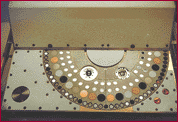


Objectives
The Optical Properties Monitor (OPM) was designed to study the effects of the natural and induced environment around the Mir on Spacecraft Materials.
Shuttle-Mir Missions Approach Results
Data gathered by the OPM has provided important data for ISS and should be reflown on ISS to assess the environment and materials performance during early ISS activities. The OPM has provided the only on-orbit data for (1) critical ISS external materials: contaminated Z93 white paint (ATCS radiator coating), ISS type chromic acid anodized aluminum, and ISS type sulfuric acid anodized aluminum, (2) refinement of ISS lifetime predictions models, (3) improvement of ground procedures of ISS materials, (4)actual degradation rates of external surfaces, (5) allow operational and maintenance planning based on actual data, (6) early verification of outgassing rates, and (7) in-space testing of new and improved materials.
Earth Benefits Publications
Optical Properties Monitor; 2nd ISS Phase 1 Research Program Interim Results Symposium; April 2, 1998.
Optical Properties Monitor; Space Environment and Effects Flight Experiments Workshop; MSFC, June 23, 1998.
In-Situ Materials Experiments on the Mir Station; SPIE 43rd Annual Meeting; July 19, 1998.
Optical Properties Monitor; ISS Optical Property Degradation Review Technical Interchange Meeting; September 29, 1998.
Optical Properties Monitor; 3rd ISS Phase 1 Research Program Interim Results Symposium; November 4, 1998.
The Mir Environment and Material Effects as Observed on the OPM Experiment; 37th AIAA Aerospace Sciences Mtg; Jan. 1999.
Principal Investigators Co-Investigators![]()
STS-81, STS-89
OPM was launched on STS-81 and transferred to Mir. It was installed on the docking module of Mir during an EVA.. OPM was exposed to the external environment of Mir for approximately 9 months then was returned to Earth on STS-89.
The OPM performed very well for the Mir mission and has provided unique data on the behavior of materials around a Space Station. Less than 200 angstroms of permanent molecular contamination was measured by the Temperature-controlled Quarts Crystal Microbalances (TQCMs). Mass accumulation rate is still above ISS requirements. No significant optical contamination effects were measured by the OPM reflectometer. Sides of OPM show significant degradation with distinct shadowing from the OPM handrails. Some flight samples were very stable for the OPM mission. The OPM reflectometer measured significant exposure effects on some flight samples. Some postflight recovery (bleaching) of environment effects have been measured on many samples verifying the need for in-space optical measurements.
As the global community begins to rely more heavily on digital and electronic communications, Earth-orbiting structures like communications satellites have become increasingly important. These satellites provide pager, telephone, television, military intelligence, and news service around the world. Because of the great expense involved in placing such satellites in orbit, longevity is a necessity. In order to achieve such longevity, ways to enhance the external structure of spacecraft need to be developed. This includes studying the impact of the space environment on new materials being considered for the external structures of both the International Space Station and new satellites. With such information, new, more durable materials can be developed that will help protect spacecraft and satellites from short life-spans in the harsh environment of space.
ISS/Mir Space Environmental Effects Experiments; ISS Contamination/Materials Technical Interchange Mtg: January 13, 1998.
Donald R. Wilkes
AZ Technology
Edgar R. Miller
James M. Zwiener
Jean M. Bennett
![]()
|
|
Curator:
Julie Oliveaux
Responsible NASA Official: John Uri |
Page last updated: 07/16/1999
.gif)